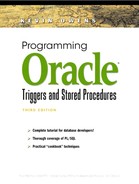2.15. Autotrace
AUTOTRACE is a SQL*Plus command that shows the execution plan for SQL statements. It is an excellent tool. We will see many options in Chapter 3 with regard to constraints, particularly primary key and unique constraints. These constraints have indexes. There are implications to actions that modify these constraints. In a development or test environment, developers may temporarily disable constraints or drop and create them. AUTOTRACE offers a quick check to see how your SQL will execute. You may assume that an index exists and that you are using it; and yet it may not. You learn when you run your application with disappointing performance.
Setting AUTOTRACE in your SQL*Plus session shows the execution path for all SQL statements in that session. The following demonstrates a select on the STUDENTS table, defined in the DDL of Chapter 4.
The following session sets AUTOTRACE. A SELECT statement is entered and executed. The AUTOTRACE shows that the SELECT statement is using the index.
SQL> SET AUTOT ON EXP SQL> SELECT status FROM students WHERE student_id='A101'; STATUS -------------------- Degree Execution Plan ---------------------------------------------------------- 0 SELECT STATEMENT Optimizer=CHOOSE (Cost=1 Card=1 Bytes=10) 1 0 TABLE ACCESS (BY INDEX ROWID) OF 'STUDENTS' (Cost=1 Card=1 Bytes=10) 2 1 INDEX (UNIQUE SCAN) OF 'PK_STUDENTS' (UNIQUE)
Suppose a developer disabled the constraint with the following.
SQL> ALTER TABLE students 2 DISABLE CONSTRAINT pk_students CASCADE;
Following the aforementioned DISABLE command, our SQL trace shows a much different result. Below is the SQL Trace result—we see that now our query is performing a full table scan. From this we will want to investigate our SQL—maybe it is not written properly or maybe a constraint or index has been dropped. Had we not used this short analysis tool, we could likely put our select statement into production having it do table scans.
SQL> SELECT status FROM students WHERE student_id='A010'; Execution Plan ---------------------------------------------------------- 0 SELECT STATEMENT Optimizer=CHOOSE (Cost=1 Card=1 Bytes=10) 1 0 TABLE ACCESS (FULL) OF 'STUDENTS' (Cost=1 Card=1 Bytes=10)
You have three types of output to consider when using AUTOTRACE.
Do you want to execute the SQL statement? You may not if the SQL takes a long time to run. Long-running SQL statements are a reason to test with AUTOTRACE. You do have the option to see an explain plan and/or statistics without fully executing the query.
You can get the explain plan—the most useful piece of information.
You can also get statistics that indicates the number of physical and logical reads performed.
The AUTOTRACE syntax is:
SET AUTOT[RACE] {ON|OFF|TRACE[ONLY]} [EXP[LAIN]] [STAT[ISTICS]]
| SQL*Plus Command | Explanation |
|---|---|
| SET AUTOT OFF | Disables AUTOTRACE for the session. |
| SET AUTOT ON | This command presumes EXP and STAT.
|
| SET AUTOT TRACE | Do NOT execute the SQL statement. This also presumes EXP and STAT.
|
| SET AUTOT TRACE EXP STAT | Same as SET AUTOT TRACE. |
| SET AUTOT TRACE EXP | Do NOT execute SQL statement.
|
| SET AUTOT TRACE STAT | Do NOT execute SQL statement.
|
The AUTOTRACE option, shown here, explains the SQL statement. It does not execute the statement. This is useful for long running queries.
SET AUTOT ON EXP
You do need a plan table for this to run. Oracle populates the plan table as it analyzes the SQL statement. The script for the plan table is found in the directory:
ORACLE_HOME/rdbms/admin/utlxplan.sql
The plan table, if you need to key in, is:
CREATE TABLE PLAN_TABLE ( statement_id VARCHAR2(30), timestamp DATE, remarks VARCHAR2(80), operation VARCHAR2(30), options VARCHAR2(255), object_node VARCHAR2(128), object_owner VARCHAR2(30), object_name VARCHAR2(30), object_instance NUMERIC, object_type VARCHAR2(30), optimizer VARCHAR2(255), search_columns NUMBER, id NUMERIC, parent_id NUMERIC, position NUMERIC, cost NUMERIC, cardinality NUMERIC, bytes NUMERIC, other_tag VARCHAR2(255), partition_start VARCHAR2(255), partition_stop VARCHAR2(255), partition_id NUMERIC, other LONG, distribution VARCHAR2(30), cpu_cost NUMERIC, io_cost NUMERIC, temp_space NUMERIC, access_predicates VARCHAR2(4000), filter_predicates VARCHAR2(4000));
